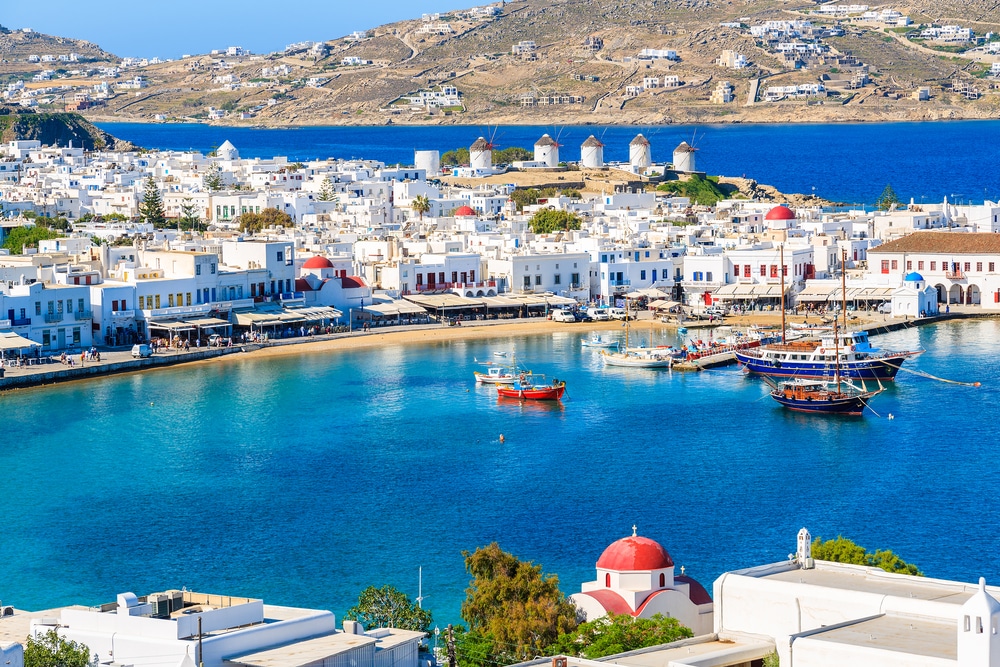Greece enjoys great popularity among holidaymakers from all over the world. In addition to the rich history in the cultural field, the country also offers a lot of interesting scenic destinations. One reason for the enthusiasm among tourists is the archipelago of the Cyclades. Interesting information about the numerous islands and which places you should definitely have seen are summarized in this overview.
Where are the Cyclades located?
The Cyclades are a group of islands in the Aegean Sea. This is located southeast of the Greek mainland and north of the well-known island of Crete. In total, the archipelago covers an area of around 2,500 square kilometres. Due to the large number of islands, this means that each island has a relatively small size and therefore invites you to extensive sightseeing in a short time. In total, a total of just over 100,000 inhabitants live on the various islands. The capital of the islands is the city of Ermoupoli, located on Syros. It has 11,000 inhabitants and is considered the cultural and economic center of the Cyclades. The Cyclades have been part of the South Aegean Administrative Region since a reform in 2010. The region is divided into 20 municipalities and 11 rural municipalities.
An important economic factor is the occurrence of foodstuffs such as wine, oil, tropical fruits or honey. In addition, fabrics such as cotton or silk also act as a source of income for the local economy.
The circular archipelago
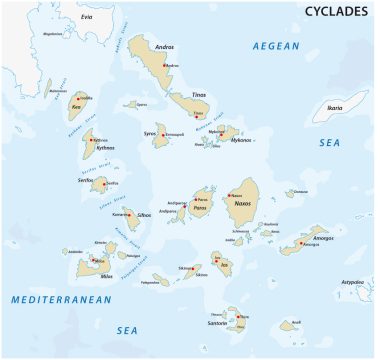
The name Cyclades is derived from the word ‘kyklos’, which means ‘circle’. This goes back to the ancient assumption that the islands are arranged in a circle around the island of Delos. The special thing about it is that Delos was considered the island of the gods and therefore played a special role within the group. The islands outside the district were accordingly given the designation Sporades, i.e. “scattered islands”. In the past, in addition to tourism, the archipelago was mainly shaped by natural events such as earthquakes and volcanic eruptions, which explain the current topography of the islands.
Which islands belong to the Cyclades?
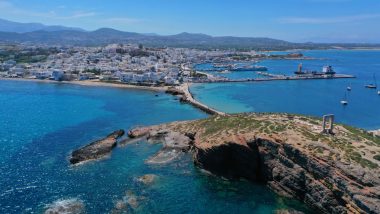
The exact number of Cyclades cannot be quantified exactly. Since some of the smaller islands are almost unfamiliar, they are not always counted as official islands. In general, however, the entirety of the islands can be summarized on around 50 islands. The largest island of the Cyclades is Naxos. Also one of the largest islands is Andros in the north of the archipelago. Mykonos and Santorini, on the other hand, are somewhat better known. The former, together with Ion, is particularly popular with young people and is known for parties. On islands such as Folegandros , the beauty of the Cyclades can be experienced in its origins.
What are the highlights of the Cyclades?
The special charm of the Cyclades is certainly its diversity. So every holidaymaker will find a place that suits his or her particular preferences. White beaches invite you to swim on almost all islands. There are also opportunities for diving or hiking. The pleasant climate also ensures that holidaymakers are offered a quiet and varied holiday everywhere. As mentioned earlier, a culture for parties has developed, especially in Mykonos, which is very popular among young people. However, if you want to take it a little easier, you can escape the large stream of tourists by visiting the neighbouring islands.
Another noteworthy destination for travelers is the island of Santorini. With around 15,000 inhabitants, the island, located in the south of the archipelago, is one of the most populous islands. Santorini, which is completely geared towards tourism, is home to many beautiful sandy beaches and serves as a popular motif for photos. As a wine-growing region, the island also has a lot to offer in terms of culinary delights. The island invites its visitors to enjoy the sunset with a glass of local wine. Furthermore, Santorini, together with Mykonos, is the main connection point for air traffic. In summer, planes fly to the island, which is why Santorini and Mykonos serve as starting points for most tourists.
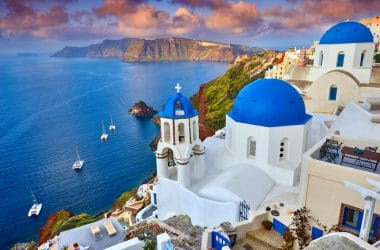
Another interesting island is Delos, mentioned as the island of the gods. This has also been named a World Heritage Site. More exciting impressions are offered by the islands of Paros in the center of the archipelago and Amorgos. This is valued above all for its comparatively decelerating effect and also differs from the other islands in terms of vegetation. Myths and legends also entwine around the two islands of Tinos and Milos. Furthermore, Andros, Sifnos and Syros are popular for their breathtaking beauty.
Due to their manageable size, the islands of the Cyclades have the advantage of being able to provide a wide range of impressions for tourists. Good ferry connections make it possible to visit many islands of the Cyclades within a relatively short time. This makes the Cyclades perfect for island hopping from one island to another. Daily connections to Piraeus are also possible from Santori, which increases the attractiveness even more.
In conclusion, the Cyclades have a lot to offer due to their unsurpassed diversity. The cultural aura that surrounds the historic archipelago can be seen in the architecture, among other things. In addition, there are the beautiful landscapes, which also explain the popularity of the Cyclades. Last but not least, each island has its own charm and there is always something new to discover on every visit.
Facts about the Cyclades
- Geographical location and composition: The Cyclades consist of about 220 islands, the most famous of which are Naxos, Paros, Santorini and Mykonos. These islands are known for their quaint blue-domed white villages, which are often seen on postcards.
- Historical significance: The Cyclades have been inhabited since the Neolithic period. Especially during the Early Bronze Age (approx. 3000 to 2000 BC), the Cycladic culture was formative for the region. This period is known for its characteristic marble idols, the so-called Cycladic idols.
-
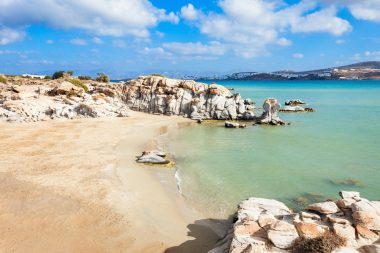
The beach Kolimbithres on Paros, Image: saiko3p / shutterstock Architecture and culture: The typical architecture of the Cyclades is characterized by simple lines, cubic shapes, and the predominant color combination of white and blue. These colours not only reflect the Greek national consciousness, but also provide a functional benefit by reflecting sunlight and thus helping to cool the buildings.
- Tourism: The Cyclades are a popular tourist destination, especially because of their beautiful beaches, clear waters, and lively nightlife. Islands such as Mykonos and Santorini are known worldwide and attract millions of tourists every year.
- Economy: In addition to tourism, many inhabitants of the Cyclades live from fishing, agriculture and, to a lesser extent, from handicraft production, especially weaving and pottery.
- Nature and environment: The archipelago is characterized by a typical Mediterranean climate, with mild, humid winters and hot, dry summers. The natural vegetation is mainly sparse and consists of low shrubs and herbs.
- Culinary: The cuisine of the Cyclades reflects the typical Mediterranean diet, rich in olive oil, fresh vegetables, fish and seafood. A well-known dish of the region is “fava”, a puree made from yellow peas.
Climatic table for the Cyclades
| Month | Average maximum temperature (°C) | Average low temperature (°C) | Precipitation (mm) |
|---|---|---|---|
| January | 12 | 9 | 74 |
| February | 13 | 9 | 48 |
| March | 15 | 11 | 37 |
| April | 19 | 14 | 22 |
| May | 23 | 18 | 15 |
| June | 28 | 23 | 5 |
| July | 30 | 25 | 2 |
| August | 30 | 25 | 2 |
| September | 27 | 22 | 10 |
| October | 22 | 18 | 40 |
| November | 18 | 14 | 59 |
| December | 14 | 11 | 71 |


